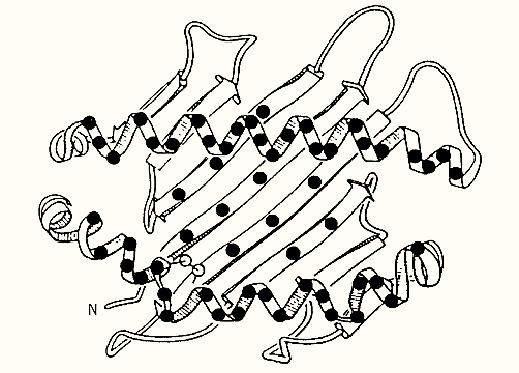

النبات

مواضيع عامة في علم النبات

الجذور - السيقان - الأوراق

النباتات الوعائية واللاوعائية

البذور (مغطاة البذور - عاريات البذور)

الطحالب

النباتات الطبية


الحيوان

مواضيع عامة في علم الحيوان

علم التشريح

التنوع الإحيائي

البايلوجيا الخلوية


الأحياء المجهرية

البكتيريا

الفطريات

الطفيليات

الفايروسات


علم الأمراض

الاورام

الامراض الوراثية

الامراض المناعية

الامراض المدارية

اضطرابات الدورة الدموية

مواضيع عامة في علم الامراض

الحشرات


التقانة الإحيائية

مواضيع عامة في التقانة الإحيائية


التقنية الحيوية المكروبية

التقنية الحيوية والميكروبات

الفعاليات الحيوية

وراثة الاحياء المجهرية

تصنيف الاحياء المجهرية

الاحياء المجهرية في الطبيعة

أيض الاجهاد

التقنية الحيوية والبيئة

التقنية الحيوية والطب

التقنية الحيوية والزراعة

التقنية الحيوية والصناعة

التقنية الحيوية والطاقة

البحار والطحالب الصغيرة

عزل البروتين

هندسة الجينات


التقنية الحياتية النانوية

مفاهيم التقنية الحيوية النانوية

التراكيب النانوية والمجاهر المستخدمة في رؤيتها

تصنيع وتخليق المواد النانوية

تطبيقات التقنية النانوية والحيوية النانوية

الرقائق والمتحسسات الحيوية

المصفوفات المجهرية وحاسوب الدنا

اللقاحات

البيئة والتلوث


علم الأجنة

اعضاء التكاثر وتشكل الاعراس

الاخصاب

التشطر

العصيبة وتشكل الجسيدات

تشكل اللواحق الجنينية

تكون المعيدة وظهور الطبقات الجنينية

مقدمة لعلم الاجنة


الأحياء الجزيئي

مواضيع عامة في الاحياء الجزيئي


علم وظائف الأعضاء


الغدد

مواضيع عامة في الغدد

الغدد الصم و هرموناتها

الجسم تحت السريري

الغدة النخامية

الغدة الكظرية

الغدة التناسلية

الغدة الدرقية والجار الدرقية

الغدة البنكرياسية

الغدة الصنوبرية

مواضيع عامة في علم وظائف الاعضاء

الخلية الحيوانية

الجهاز العصبي

أعضاء الحس

الجهاز العضلي

السوائل الجسمية

الجهاز الدوري والليمف

الجهاز التنفسي

الجهاز الهضمي

الجهاز البولي


المضادات الميكروبية

مواضيع عامة في المضادات الميكروبية

مضادات البكتيريا

مضادات الفطريات

مضادات الطفيليات

مضادات الفايروسات

علم الخلية

الوراثة

الأحياء العامة

المناعة

التحليلات المرضية

الكيمياء الحيوية

مواضيع متنوعة أخرى

الانزيمات
Heterosis
المؤلف:
T. Gojobori and T. Imanishi
المصدر:
Transplantation Now 4, 26
الجزء والصفحة:
17-5-2016
2987
Heterosis
Heterosis is the phenomenon in which heterozygotes exhibit superiority of fitness over homozygotes . This superiority often occurs in the areas of viability, longevity, fecundity, and resistance to disease. Therefore, heterosis is sometimes referred to as “hybrid vigor”. Heterosis occurs when two different, often inbred strains are crossed. The effect of homozygous deleterious alleles is reduced in the heterozygotes produced through the cross. The increase in vigor may be due to overdominance or superiority of the heterozygote for particular gene differences, or to the introduction of favorable dominant alleles to loci previously homozygous for deleterious recessive alleles. Therefore, the terms “heterosis” and “overdominance” are used interchangeably; both confer heterozygotes with an evolutionary advantage over homozygotes.
When survival or reproduction is lowered with recessive alleles, such alleles are eliminated faster from inbred homozygous populations than from outbred, heterozygous populations. Homozygous deleterious alleles will first increase, and then natural selection will tend to remove the deleterious alleles, resulting in less genetic variation and greater average fitness as the heterozygous alleles increase. However, deleterious recessive genes will not be totally eliminated by selection, because they will not be exposed to selection in the heterozygotes.
The major histocompatibility complex (MHC) genes in humans and mouse are known to have extremely high numbers of alleles (Figure 1) (1). Since the number of alleles is much greater than expected if the alleles were all equivalent functionally, it has been long speculated that positive selection is operating on these complex genes. By making combinatorial sets of different alleles, an organism can become resistant to viral infection, which confers superiority of fitness over the homozygote. Thus, the MHC genes are counted as one example of overdominance.

Figure 1. The protein structure of the MHC human protein, HLA Class IA. The residues involved in binding antigen are shown by the closed circles (1).
Hughes and Nei (2) examined the numbers of synonymous and nonsynonymous substitutions in the MHC genes. They found that the number of nonsynonymous substitutions, which change the amino acid, was significantly greater than that of synonymous substitutions in the antigen-recognition sites, even though the opposite occurred elsewhere. They concluded that positive selection, most probably by overdominance or heterosis, is operating only on the antigen recognition sites.
References
1. T. Gojobori and T. Imanishi (1991) Transplantation Now 4, 26.
2. A. L. Hughes and M. Nei (1988) Nature 335, 167–170.
 الاكثر قراءة في مواضيع عامة في الاحياء الجزيئي
الاكثر قراءة في مواضيع عامة في الاحياء الجزيئي
 اخر الاخبار
اخر الاخبار
اخبار العتبة العباسية المقدسة

الآخبار الصحية















 قسم الشؤون الفكرية يصدر كتاباً يوثق تاريخ السدانة في العتبة العباسية المقدسة
قسم الشؤون الفكرية يصدر كتاباً يوثق تاريخ السدانة في العتبة العباسية المقدسة "المهمة".. إصدار قصصي يوثّق القصص الفائزة في مسابقة فتوى الدفاع المقدسة للقصة القصيرة
"المهمة".. إصدار قصصي يوثّق القصص الفائزة في مسابقة فتوى الدفاع المقدسة للقصة القصيرة (نوافذ).. إصدار أدبي يوثق القصص الفائزة في مسابقة الإمام العسكري (عليه السلام)
(نوافذ).. إصدار أدبي يوثق القصص الفائزة في مسابقة الإمام العسكري (عليه السلام)


















